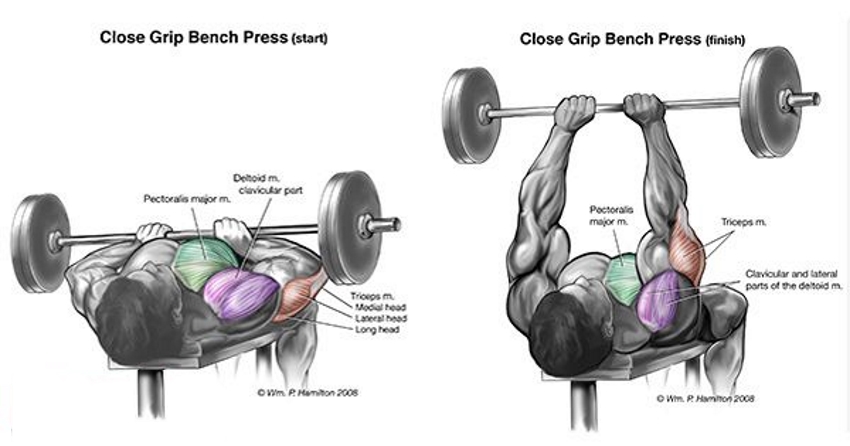The close grip bench press, or narrow grip bench press effectively works the inner pectoral muscles, shoulders and mainly the triceps muscles. What makes it a perfect arm exercise is the focus on your triceps and, to a lesser extent, the front deltoids instead of the chest area as in the case of traditional bench press.
Proper execution of the close grip bench press without over-stressing chest muscles
1. Adjust the weights so that they allow maximum range of motion. The racks should rest in a position that enables careful lifting of the back without excess arm movement or serious stretching.
2. Lie with your back flat against the bench and keep your feet planted firmly against the floor. It is most comfortable to keep your feet on either side of the bench.
3. Place your hands on the bar, six inches apart (or a little narrower than your shoulders width), palms facing upwards. If this is not comfortable, it is possible to widen your grip; however, different grips will utilize different muscle groups.
4. Carefully extend your arms so that the bar is off the rack. Do not lock your elbows.
5. Slowly, and in a controlled motion, move the bar so that it rests just above your chest. Lower the bar (with the assistance of a spotter) so that it is just above your chest. Keep your elbows tight and as close as you can to your torso. Rest. Press the bar upward in a controlled and fluid motion.
6. Repeat for as many reps as comfortable. Utilize slow and controlled motions, do not bounce up and down.
Tips for maximum efficiency of the close grip bench press
ALWAYS try to perform this exercise with the assistance of spotter. If there is no spotter available, many gyms provide access to a smith machine or a cage with safety bars. The smith machine uses a catching mechanism to prevent the weight from crushing your chest if you are unable to complete the rep.
Always perform each rep in a smooth and controlled motion. Avoid resting the weights on your chest.
This exercise is a compound movement and carriers great risks if done incorrectly. Care should be taken to warm up properly and should not be done at full weight or speed until you are certain of the limitations of your body.
A spotter could save your life. Any exercise that requires significant weight be lifted above the head should be done with the assistance of a spotter. Should the weight suddenly become too heavy, the risk of serious injury is severe.
